
26
Nov
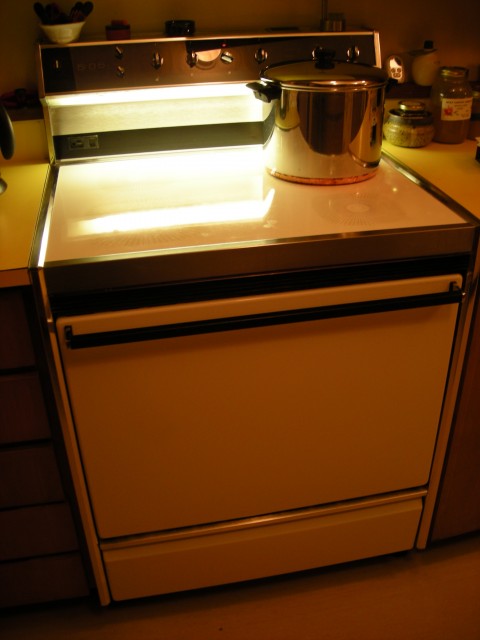
Corning Stove, January 1975 - present
She Kept the Stove Top Clean
To savor life some suggest the exercise to write your own obituary. As if preparing for death highlights what is important in the present and what survives.
When Jack Marinsky and Larry Glendenin discovered element 61, a rare earth, in the reactor at Oak Ridge in the spring of 1945, they approached my mother to name it. She invoked Prometheus, saying, “Like Prometheus, you have stolen fire from the gods and mankind may suffer for it.” Thence the name, Promethium. Prometheus’ punishment was to be chained to a rock and to suffer daily attacks of an eagle eating his liver. From his daring, humankind benefitted. Taming fire enabled survival in cold places and developments in agriculture, gender roles, and cooking.
Remembering them all, in my turn, I invoke Hestia, hearth-tender for the gods on Mount Olympus, for me, just out of sight past the bicuspid Brothers to the west in the State of Washington. My hearth is not a natural fire, dancing over kindling or coal, but a space-age Corning ceramic cook-top and oven. The late burly chef James Beard who made a tiny 33-1/3 rpm vinyl record to accompany the manual called it “a cooking appliance.”
Newly pregnant with our firstborn child, we bought the cooking appliance in January of 1975, in order to stop squabbling about who would clean the tricky spiral coils and readily burnt saucers of the original electric stove in our kitchen. The salesman glowed about the toughness of the heat-strengthened ceramic surface and and did not refuse Seelye’s test to drop his bonafide Swiss Army knife from as high as he could reach above the demo model. He did. No chip, no crack. Moreover, the self-cleaning oven proved well-insulated, with a see-through window and light to illumine the capacious interior.
The smooth glossy white surface sold us. To clean: simply wipe it with a paper towel and Bon Ami or Corning cleaner whose oxalic acid component does not scratch the ceramic. Occasionally use a single-sided razor blade to scrape burnt deposits. The top can hold a liter of spilled fluid, too. When cool, it serves as a counter, making space in a two-fanny kitchen for unloading groceries, rolling out pie crust or kneading bread. Bright lights indicate when the burners or “tempassure” units, are at the designated degrees Farenheit; when cooling, HOT; or when completely cool, OFF.
The clock with digital display, accomplished by rolling plates clicking in place to form the numbers, controls the self cleaning, timed baking, and a plug-in outlet for other appliances like a coffee maker or crock pot. With age the mechanism turning the plates has worn. We are now using the third replacement clock. Since the price of that idiosyncratic part has risen like college tuition we use exterior timers and set the clock after power outages or seasonal changes, by throwing the coupled circuit breakers downstairs in the basement. This requires complicated arithmetic. We console each other that the aging of the cooking appliance delays our own by requiring mental agility to calculate to the minute the correct time! Thanks to the Babylonians for base 60 math.
A key feature of this modern hearth is that three of the four circular heating elements contain at their center a ring with imbedded thermistors.These insure that the the temperature on the bottom of the flat pot matches that selected on the dial. Because these “tempassure” circles require direct, full contact, a warped, footed, or charred pan will not heat well. Properly employed and cleaned for optimum heat transfer these units allow dependable simmering and no boiling over. The fourth circle, larger of the two sizes, functions like a regular electric coil, pumping out heat on low, hotter and high settings. It takes a long time to cool. The designers of this post-Sputnik stove, however, failed to plan for cooking stir-fries in the ancient spun-steel round-bottom wok. Slower to come to breathe, woks work, but not like over a hot gas fire. But then, new pilotless gas stoves cannot hold a low simmer like this one.
Too, I know the inventor of its catalytic converter which cleans the exhaust during the self-clean cycle. Chemist Henry Petrow once asked me if I smelled yeast at the end of the self-clean cycle. He explained that it would have exponentially expensive to catalyse the exhaust through two more steps, to alcohol and to water. “Yes,” I replied, but it feels natural to have a yeast smell and preferable to the intermediate step, alcohol, signaling the end.” Alcohol does not have happy associations in my family, yeast does. “The kingdom of heaven is like yeast…”
I love this stove. I love the man who bought it with me and shares the care, cooking, and cleaning of it. It makes for joy to think of all the meals, parties, soups for the well and sick, bread, pumpkins, turkeys, roasts, play dough sculptures, cookies, science experiments that have changed phase in its embrace. I delight in the calculations for timed bake, timed self-clean, and resets for power lapses and seasonal time change. Fall back, spring ahead.
My father wrote and I approved for my mother’s grave stone,
Grace Mary Seeley Coryell
14 September 1914 – 5 May 1965
Beloved Wife, Mother, Poet.
Although I cherish the words “Belles Lettres,” and I would prefer to be cremated and nourish “flars,” and maybe have some bone bits sprinkled in the ocean like my father’s in the Pacific, I could do worse than have my heirs write,
Hearth-tender, She Kept the Stove Top Clean.
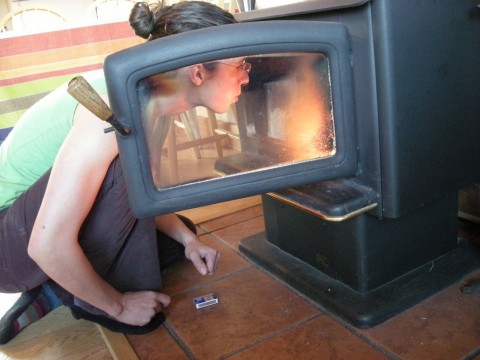
Maria tending the wood stove, Twisp, WA, October 2009
26
Oct
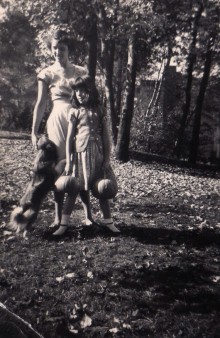
Grace Mary, Julie and Fluffy Coryell, 27 Independence Ave., Lexington, MA, ca. 1950
My mother, Grace Mary, loved Halloween. When I was little, she crafted memorable costumes for me. The first costume I remember was simple and characteristic of my mother’s humor. She transformed me into Gus the Ghostwriter from Crockett Johnson’s Barnaby and Barnaby and Mr. O’Malley cartoon books, popular during World War II. She covered the toddler me from head to toe with a simple sheet, cut out the eyes and embroidered black cotton glasses and belted the outfit with a lightweight chain just like the nearsighted comic anxious Gus.
When I was four she made my favorite, preparing it over several weeks of delicious suspense. First she soaked an old pair of footed one-piece pajamas in spent coffee grounds and hung them on a line in the basement to dry. A dear friend of the family, Hazel Lumbert, my father Charles’s former secretary the year he wrote the PPR, provided a realistic painted molded-rubber mask for the outfit. Lastly, she enlisted my help to cut out and color four cardboard flaps to disguise my gloves and shoes as …paws. Came dusk she dressed my wriggling animal self as a wonderful wolf!
As I set out on all fours to prowl around the kitchen, the back doorbell rang. Mr. Luongo was delivering fresh laid eggs. My mother opened the door to greet him. When I appeared around the refrigerator as a wolf, he almost dropped all the eggs. Because my mother had so skillfully engaged me in the process of making the wolf suit, I relished the power of being scary.
Not too much later, she turned me into the Easter Bunny with the hallmarks of Lewis Carroll’s White Rabbit: red vest, perky ears held upright by stuffed Kotexes, a prominent gold watch, and white gloves. As Gus was a scared ghostwriter, her creation of me carrying offerings to our neighbors of painted eggs on a silver tray celebrated Easter in a secular way with literary elegance.
I believe now that her energy and imagination at work for me was spiritual. She taught me the real meaning of All Hallow’s Eve and that the spooky celebration heralds two days of honoring the dead, first saints and then all souls. As the early November days passed, my mother would grow sad. She was remembering her mother, Grace Louise, who in 1900, married Frank Seeley and moved from prosperous Leavenworth, Kansas, to the isolated boom mining town at 9,400’ of Goldfield, Colorado, above more famous Cripple Creek. In 1902, Thomas D’Entremont Seeley was born. Because of the altitude, threats to health and difficulties for children, the family moved to Colorado Springs. Frank Seeley, Jr. was born in 1908. My mother was born during the Battle of the Marne, on the Feast of the Trinity, September 14, 1914.
I know she had fun growing up zestful for horse riding, camping, hiking, making and cooking over fires. Her older brothers teased her devotedly. They told her to dig a deep hole in the back yard and she would reach China. She loved a big white stuffed bear named Snowball. She and her pals loved to visit the Chinese curio dealer in town. They would knock on the screen door and ask if they could enter, announcing, “We smell punk.” The storekeeper would invite them in, “You sit in the corner and no one will notice.” All my growing up my mother delighted in spontaneous witty wordplay: puns, repartee, telling quotes.
In her high school years, Grace Mary deepened her love of language. She wrote poetry and formed a writers’ circle. With her lifelong friend, Joanna Jolly Ritzman she supplied all the senior quotes for their yearbook. Although both of her brothers in turn went to nearby Colorado College, the Great Depression was gathering, so that by her graduation in June, 1932, there was no money for her to attend college. By documenting in her book The Invisible Scar the Depression era loss for women in opportunities for education, employment and vocation, Caroline Bird has helped me understand Grace Mary’s lasting sorrow for her lost chance.
I do not know what my mother did for herself after graduation beyond writing, cooking and homecare for her family. Before their marriage, 2 December 1937, she had published thirteen poems, more than my father had papers in print. She did have a well-loved black and gold-trimmed Remington portable typewriter that was only replaced by a snazzy Olivetti Lettera 22 teal blue portable when I was in high school. It is indelible on my heart that on the afternoon of November 4, 1932, eighteen-year old Grace Mary and sixty-year old Grace Louise went shopping together. They arrived home, and Grace Louise starting coughing. Grace Mary held her but the coughing would not stop. Within 15 minutes, Grace Louise died of a collapsed aorta in her daughter’s arms.
Knowing this story and impatient with my own sorrows, in her 19th year, my daughter Maria exclaimed to me, “You carry your mother around like a dead ghost.” I do. I do. I have felt it a duty and a love to make vivid to my children the dear and the good about my mother, and her woundedness. As my suitor, their father fell in love with my mother, her humor, her cooking, her hospitality despite her deadly addiction to alcohol and barbiturates. And I miss her. I long for her witty and comforting mothering that shone through the bad periods of our life together. Above all, I have tried to keep healthy, to understand her illness and grief, my own vulnerabilities, and to propagate in a hungry world, the nurturance and love for her child, that I always felt in her company. Holy ghosts and Holy Spirit.
19
Jun
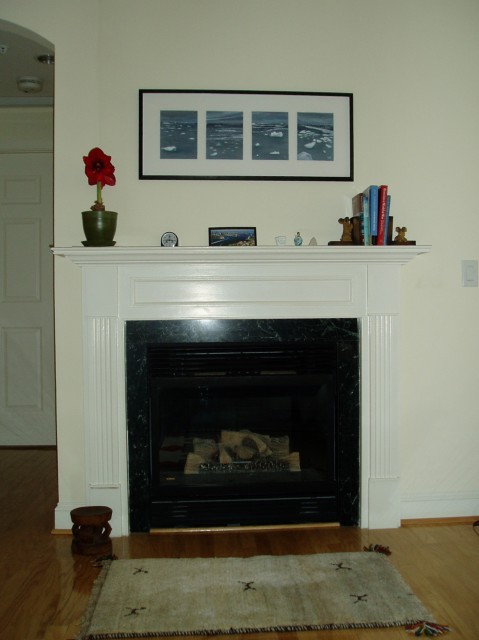
Our mantel at The Kennedy-Warren in DC. Evening Ice in Antarctica by Maria Coryell-Martin, October 2006.
The legendary giant Paul Bunyan once overwintered in a lumber camp in northern Minnesota. It was so cold the lumberjacks’ cuss words froze midair. Tough living, rough language. In springtime when sunshine warmed the air, the words all thawed and assaulted their ears!
Likewise, reentry to our home in Seattle after two plus years in Washington, DC, suddenly highlights every item stored, shipped, lost, found. “Do I need this? Do I use this? Do I love this? These questions of organizers in the business Empty Your Nest founded by our adopted sisterperson now residing in Berlin, Germany, echo relentlessly in my ears. And, is there a friend who would enjoy this item? Is it recyclable or saleable and at what cost? If I toss it, what life awaits in the landfill or at sea?
Feeling at sea myself, queasy with responsibility, awareness pressing on my conscience, I reflect that paralysis is not helpful. As Seelye has continued to work on the cryosphere for NASA, I remind myself that upon entering the Earth’s atmosphere, the space shuttle routinely loses protective heat tiles. Prepare for fatality, expect friction, ride the ride.
Coming home, I notice that trees are taller and elders, shorter. Our cat sleeps more and bosses us more authoritatively. Government has poured more cement, especially around highways. Life and place are both familiar and new. It seems imperative to live into our aging differently than our parents and boldly to extend “the examined life” into our footprint on the land and ecosystem.
In the financial meltdown, amidst species loss, swine flu threat, so many changes seem logical, if unanticipated consequences of past policies. I stick to the simple, the concrete. I seek first principles. There is no going back. This Earth is our home, and faith, a refuge.
When she wrapped me toga-style in a towel from my bath, my mother taught me, “Friends, Romans, and countrymen, let me lend you my ears…” Jesus said, “Let those with ears, hear.” What are we hearing now? Can we begin the deep conversations needed to respond, creatively, honestly at the fundament, the very root? And what of the branches, the evolution, our future?

Fatimata's house, Karal, Mali. Walnut ink on tinted paper by Maria Coryell-Martin, February 2005.
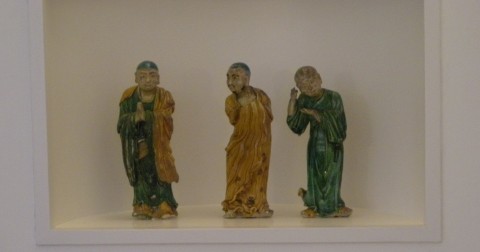
Chinese figurines, Tang style at the Weizmann Home, Weizmann Institute, Rehovoth, Israel. February 2008.

Roman ruin at Masada, Israel. Tristram's Grackles. February 2008.
22
Apr

Magnuson Park Dandelions, Seattle, April 2009
Spring is fulling, the ground, still moist. Woolens beg for washing to withstand hungry moth larvae soon to invade closets and cupboards. Welcome sunshine emboldens myriad yellow Compositae family Taraxacum officinale flowers that dot garden beds and carpet the lawn. Left to seed, each head can produce hundreds, maybe thousands of offspring. Mulling my computer, the economy, and the dandelions, big numbers engross me.
Determined, I address the task of hand-pulling or dousing them with five percent vinegar. Although in a week, I have spotted only one head gone to seed, time presses. What can one woman do? Purportedly introduced to her medicinal garden by pioneer nurse Catherine Broshears Maynard (1816-1906) in the early days of Seattle Alki, meaning by and by, now they penetrate everywhere. Edible, the young greens can be added to salad, the roots roasted, and the flowers fermented into wine. Still, neither the slow cooking movement nor the pangs of poverty have sparked harvesting them for food or drink.
This week, Seelye is surveying by airplane the ice extent of the Arctic Ocean and Greenland ice sheet to assess multiyear and first year ice. As I poke, pry, uproot each plant, I consider its age and extent. Often the wily plant releases its surface green leaves and stems to preserve the root below, like a salamander shedding its tail to escape capture. The older the plant, the more entwined with grass, moss, other plants the roots grow, resembling sexy ginseng or carrots, creatures with fanciful underground legs, some hairy, some smooth. Occasionally, the complete plant yields neatly to my tug. Multi-year dandelions and first-year slim-jims.
Lao Tze asked, “What is the usefulness of the useless?” I ponder. Why do I do this? What can I hope to achieve? Last week I worked so hard, I broke a blood vessel under my wedding ring. My finger and hand numbed and tingled. I ached in my armpit and across my chest. I called the consulting nurse who went into high gear to ensure that I was not having a heart attack. Not breathless, not nauseated, not dizzy. Good. Yes, weary, sore and feeling depleted. Grateful to have health insurance, and embarrassed at the scrutiny, during my wait to see the doctor, I rested! The young doctor validated my reading of my body. Catch and release.
Now in my hunt for these lions, I proceed more mindfully. Shorter sessions, with a new long-handled weeder allow me more angles and exercise, even standing up! I experiment with delivery and quantity of vinegar. I lie down and drink water more consciously. Clever plants – when mowed, they grow back with shorter stems! Tempted to poison them, the view of Lake Washington squelches that thought. I seek help, reinforcements.
Lions’ teeth, they have their place in the universe. I cannot escape their presence. I would miss never seeing a single one. These sun-savvy dancing legions clamor: in my home, garden, neighborhood, in my skin, heart, bones, and in my family, genus, species – how I live matters.
Happy Earth Day!
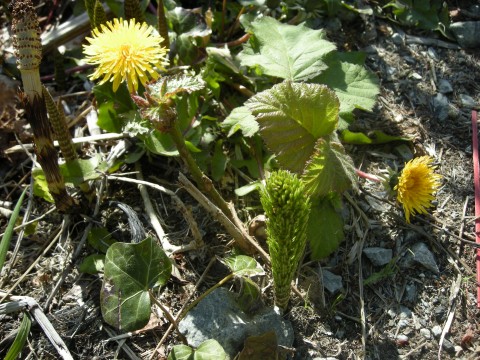
Northwest Invasives. Horsetail, Dandelion, Ivy, Himalayan Blackberry
23
Mar
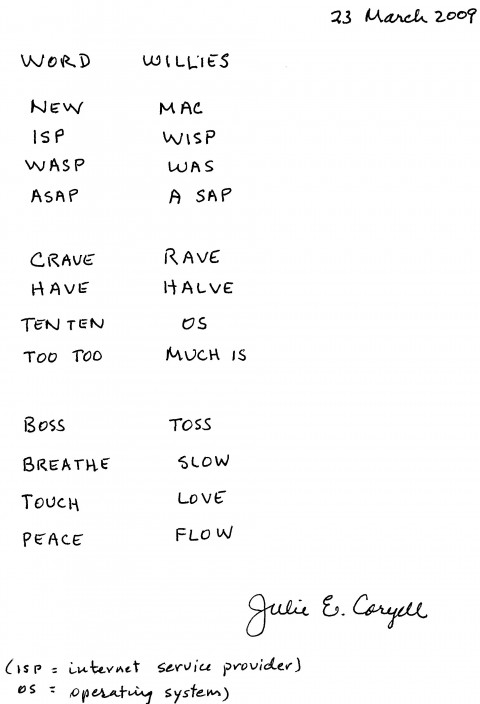
This poem draws on classic Chinese poetry composed of characters brushed in parallel vertical rows combined with my love of anagrams and Scrabble. In the midst of multiple computer woes, expressing myself trumped stressing myself.